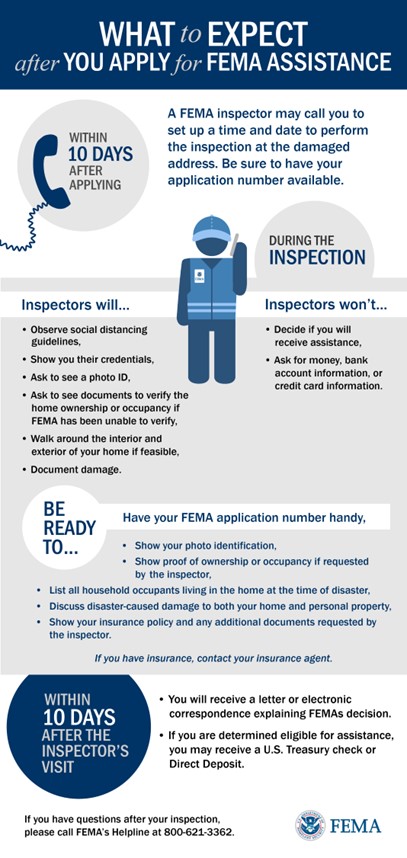If you applied to FEMA for assistance, a FEMA inspector will contact you to set up a home inspection to review damages from Tropical Storm Helene and determine whether a home is safe, sanitary and livable. Here is what to expect from the home inspection process.
Before a FEMA inspection
After you apply for disaster assistance, FEMA may verify your disaster-caused damage through an inspection.
Within 10 days of submitting an application, FEMA staff and inspectors may call to discuss your disaster-caused damage and schedule an appointment for an inspection.
The call to schedule an inspection will probably come from an out-of-state phone number. An inspector will attempt to contact you three times over three different days. If inspectors cannot reach you after three attempts, your case will be closed until you contact FEMA again.
A FEMA inspector will schedule a time to visit your home. FEMA inspectors will not show up to your home without an appointment.
Get the following documents and information ready for the inspection:
- Your FEMA application number. An inspector may ask for the last four digits.
- Your photo identification.
- Proof that you owned or occupied the house at the time of the disaster.
- A list of all household occupants living in the home at the time of disaster.
- A list of disaster-caused damage to both your home and personal property. Collect any photos or videos of the damage.
- Your insurance policy information.
Documents you can use to prove ownership or occupation include:
Occupancy: driver’s license, utility bill, merchant statement, lease, rent receipts, pay stub
Ownership: mortgage statement, insurance policy information, tax bill or receipt
During a FEMA inspection
The inspection process usually takes 30 to 40 minutes. If you were able to take photos or videos of interior or exterior damage to your home, show them to the inspector.
If you had damage to a private well, share that information with the inspector at the time of inspection.
The inspector will:
- Verify your name, address, contact information, and insurance;
- Confirm the individuals living in your disaster-damaged residence; bedrooms occupied; clothing, medical, dental, transportation, or miscellaneous losses; and items you purchased as a result of the disaster (e.g., chainsaw, dehumidifier);
- Assess your pre-disaster residence’s structure, furniture, and appliances for damage caused by the disaster, as well as undamaged items;
- Document your pre-disaster residence’s square footage, foundation, and structural type (e.g., one or multiple stories). Record the cause of damage, applicable water levels, impacted utilities, and accessibility features; and
- Confirm with you all damage has been viewed and describe next steps in the FEMA process.
The inspector will always have an official FEMA badge and will never ask for your Social Security number.
If you are unable to meet with the FEMA inspector for an in-person inspection, you can have a friend or relative meet with the inspector on your behalf. But first, you must provide FEMA with a signed request for another person to be at your home for the inspection. This document allows another person—who is at least 18 years old—to meet with the inspector and talk about your case with FEMA.

After a FEMA inspection
Within 10 days following an inspector’s visit, you will receive a letter or electronic correspondence explaining FEMA’s decision. Please read your letter carefully. Your letter may have information about next steps you need to take.
Please note: not all losses require an inspection. You should also monitor your mail or your FEMA Online Account at DisasterAssistance.gov and respond to any requests from FEMA.
If you have any questions before, during or after your inspection, please call FEMA’s helpline at 800-621-3362.
For more information on Virginia’s disaster recovery, visit vaemergency.gov, the Virginia Department of Emergency Management Facebook page , fema.gov/disaster/4831 and facebook.com/FEMA.
FEMA’s mission is helping people before, during, and after disasters. FEMA Region 3’s jurisdiction includes Delaware, the District of Columbia, Maryland, Pennsylvania, Virginia and West Virginia. Follow us on X at x.com/FEMAregion3 and on LinkedIn at linkedin.com/company/femaregion3.
Disaster recovery assistance is available without regard to race, color, religion, nationality, sex, age, disability, English proficiency, or economic status. If you or someone you know has been discriminated against, call FEMA toll-free at 833-285-7448. If you use a relay service, such as video relay service (VRS), captioned telephone service or others, give FEMA the number for that service. Multilingual operators are available (press 2 for Spanish and 3 for other languages).

